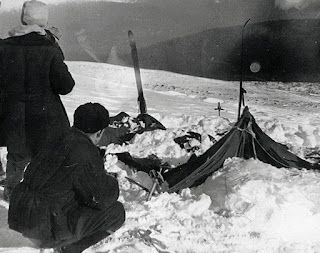The Dyatlov Pass Incident: A Perennial Mystery
On the fateful night of January 27, 1959, nine skilled hikers from the Ural Polytechnic Institute, led by Igor Dyatlov, embarked on a treacherous journey through Russia's northern Ural mountains. Their ambition was to conquer Gora Oterten Mountain, but destiny had other plans. Tragically, all members of the expedition perished under mystifying circumstances on the desolate slopes of Kholat Syakhl—aptly known as "Death Mountain" by the indigenous Mansi people.
The enigma deepened when, a month later, a search party stumbled upon their tent, bizarrely slashed from within, with personal effects left untouched. A trail of footprints, some barefoot or partially clad, led away from the camp, only to vanish into the snowy abyss. Nearby, two lifeless bodies were discovered by remnants of a fire, scantily dressed and bearing signs of burns. Further searches revealed more victims, frozen in desperate postures, hinting at a frantic attempt to return to safety. The final group was found months later in a ravine, with disturbing injuries including missing eyes and a torn tongue. While Soviet officials attributed the deaths to a mixture of physical trauma and hypothermia, the true cause remains a source of speculation to this day.
Unsolved Enigma: Theories Behind the Dyatlov Pass Tragedy
The Dyatlov Pass incident has captivated the public imagination, spawning a myriad of theories from the plausible to the fantastical—avalanches, alien encounters, cryptid attacks, and covert military operations among them. Issa López, in conversation with Vanity Fair, expressed a preference for the enigmatic, suggesting that the incomplete puzzle of Dyatlov Pass continues to ignite our curiosity and frustration, keeping the mystery alive in our collective consciousness.
Human Cryogenics: The Science Behind the Sci-Fi
The haunting concept of a human "corpsicle"—as dramatized in True Detective—brings forth the question: Can humans endure extreme freezing? Professor Gary Bryant, a leading physicist, offers a definitive response: survival in such conditions is a scientific impossibility. Our bodies, with a normothermic baseline of 37°C (98.6°F), begin to succumb to hypothermia at merely a couple of degrees lower. The formation of ice within our bodies, a consequence of subzero temperatures, spells almost certain doom for our cells and, by extension, our very existence.
The Fatal Freeze: Why Ice Spells Death for Human Cells
As our internal temperature plummets below the freezing point, the cold wreaks havoc on our cells long before ice crystallizes. Once ice forms, the expansion of water molecules leads to cellular rupture—a lethal event for any organism. Despite the resilience of certain extremophiles like tardigrades, our human physiology, with a composition of 60% water, is not equipped to withstand the expansion and subsequent cellular damage.
While the eerie allure of a survivor emerging from a frozen tomb captivates audiences in fiction, the stark reality of human cryogenics leaves no room for such outcomes. At Freeastroscience.com, we confront the mysteries of the universe with a blend of wonder and scientific rigor. For those intrigued by the confluence of history, science, and storytelling, we invite you to continue this journey of discovery with us. Explore more articles, engage with our vibrant community, and let's unravel the complexities of our world together.


Post a Comment